Northern Hemisphere Urban Heat Stress and Associated Labor Hour Hazard from ERA5 Reanalysis
Abstract
1. Introduction
2. Data and Methodology
2.1. Dataset and WBGT Calculation
propDirect, ZenithAngle, 1)/)
ZenithAngle, MinWindSpeed)/)
2.2. WBGT Flag Conditions
2.3. Urban Areas
3. Results
3.1. Continental Scale WBGT*
3.2. Urban Scale WBGT*
3.2.1. Asia
3.2.2. Europe, Africa, and North America
4. Discussion
4.1. South Asian WBGT*
4.2. Heat Hazard
5. Conclusions
Author Contributions
Funding
Institutional Review Board Statement
Informed Consent Statement
Data Availability Statement
Acknowledgments
Conflicts of Interest
Appendix A. WBGT* in Selected Urban Regions

Appendix B. Cloud Forcing and Latent Heat Correlation with Rest Hour
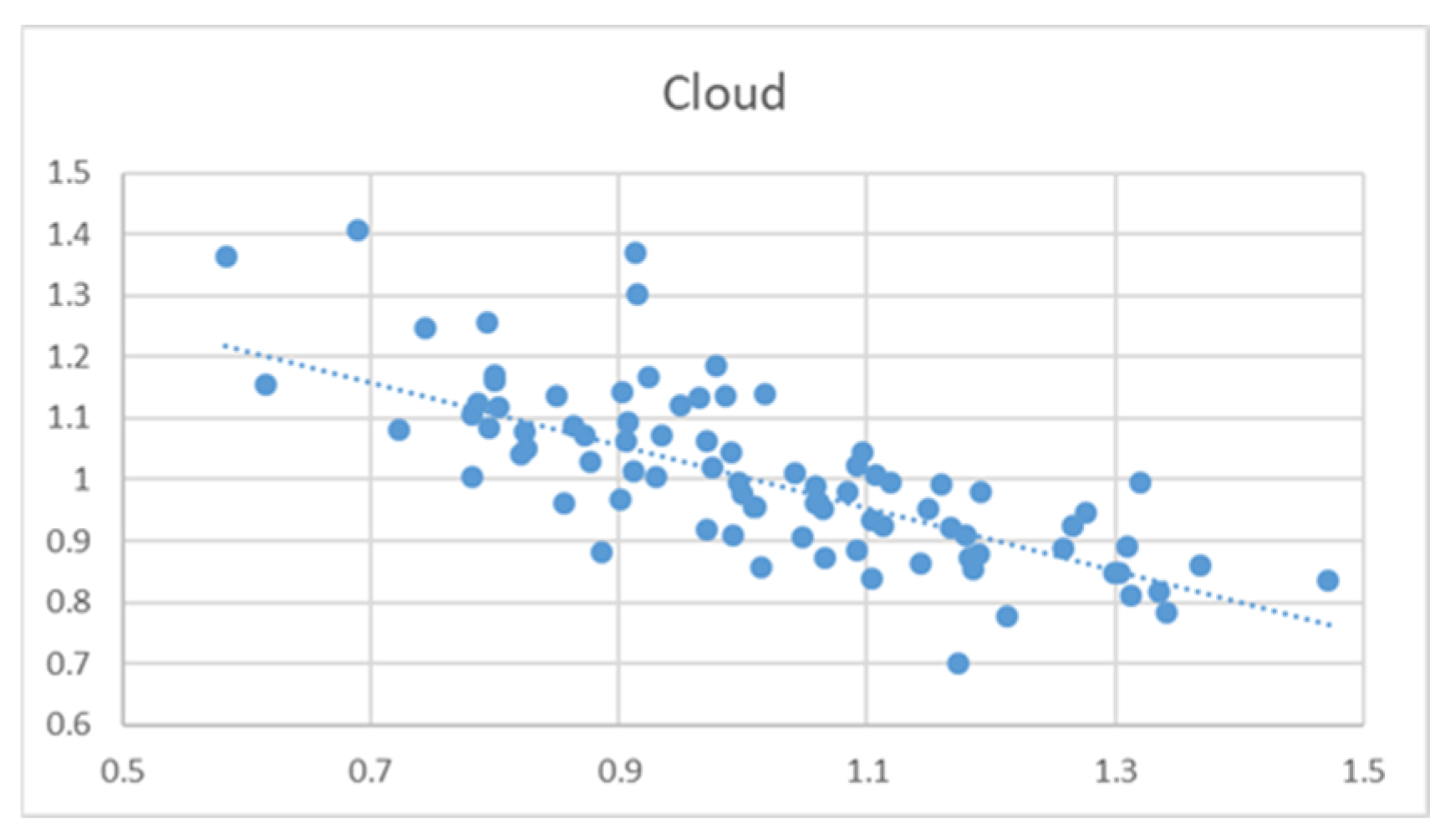
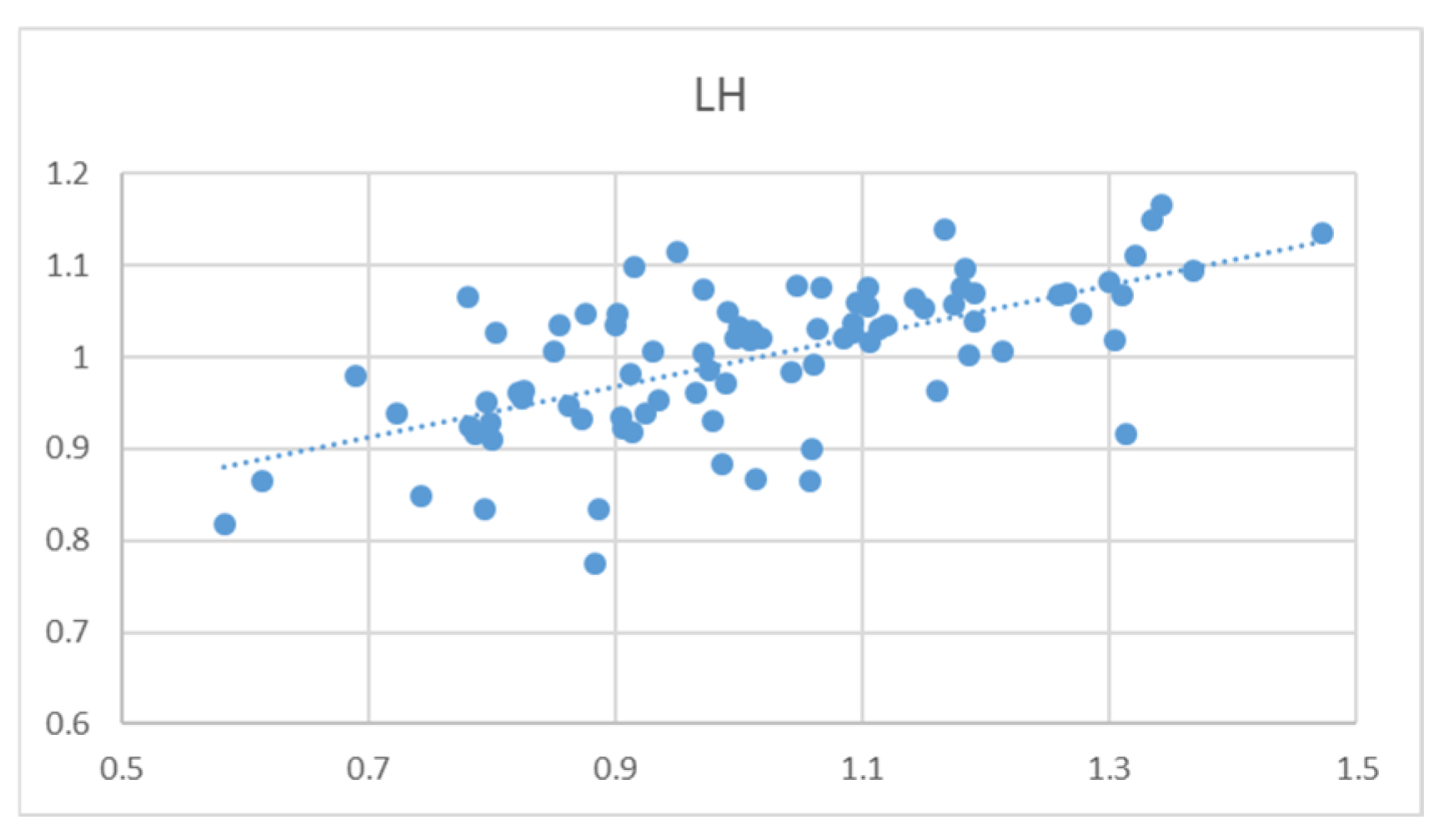
References
- Dosio, A.; Mentaschi, L.; Fischer, E.M.; Wyser, K. Extreme heat waves under 1.5 °C and 2 °C global warming. Environ. Res. Lett. 2018, 13, 054006. [Google Scholar] [CrossRef]
- IPCC. Climate Change 2014: Synthesis Report. In Contribution of Working Groups I, II and III to the Fifth Assessment Report of the Intergovernmental Panel on Climate Change; IPCC: Geneva, Switzerland, 2014. [Google Scholar]
- Berko, J.; Ingram, D.D.; Saha, S. Deaths Attributed to Heat, Cold, and Other Weather Events in the United States, 2006–2010. Natl. Health Stat. Report 2014, 76, 1–15. [Google Scholar]
- St-Pierre, N.R.; Cobanov, B.; Schnitkey, G. Economic Losses from Heat Stress by US Livestock Industries. J. Dairy Sci. 2003, 86, E52–E77. [Google Scholar] [CrossRef]
- Wheeler, T.R.; Craufurd, P.Q.; Ellis, R.H.; Porter, J.R.; Prasad, P.V.V. Temperature variability and the yield of annual crops. Agric. Ecosyst. Environ. 2000, 82, 159–167. [Google Scholar] [CrossRef]
- WHO. Heat and Health. Available online: https://www.who.int/news-room/fact-sheets/detail/climate-change-heat-and-health (accessed on 1 April 2022).
- Dunne, J.P.; Stouffer, R.J.; John, J.G. Reductions in labour capacity from heat stress under climate warming. Nat. Clim. Chang. 2013, 3, 563–566. [Google Scholar] [CrossRef]
- Gasparrini, A.; Guo, Y.; Sera, F.; Vicedo-Cabrera, A.M.; Huber, V.; Tong, S.; Coelho, M.d.S.Z.S.; Saldiva, P.H.N.; Lavigne, E.; Correa, P.M.; et al. Projections of temperature-related excess mortality under climate change scenarios. Lancet Planet. Health 2017, 1, e360–e367. [Google Scholar] [CrossRef]
- Kotz, M.; Wenz, L.; Stechemesser, A.; Kalkuhl, M.; Levermann, A. Day-to-day temperature variability reduces economic growth. Nat. Clim. Chang. 2021, 11, 319–325. [Google Scholar] [CrossRef]
- Kovats, R.S.; Hajat, S. Heat stress and public health: A critical review. Annu. Rev. Public Health 2008, 29, 41–55. [Google Scholar] [CrossRef]
- Kjellstrom, T.; Freyberg, C.; Lemke, B.; Otto, M.; Briggs, D. Estimating population heat exposure and impacts on working people in conjunction with climate change. Int. J. Biometeorol. 2018, 62, 291–306. [Google Scholar] [CrossRef]
- Zare, S.; Shirvan, H.E.; Hemmatjo, R.; Nadri, F.; Jahani, Y.; Jamshidzadeh, K.; Paydar, P. A comparison of the correlation between heat stress indices (UTCI, WBGT, WBDT, TSI) and physiological parameters of workers in Iran. Weather. Clim. Extremes 2019, 26, 100213. [Google Scholar] [CrossRef]
- Zare, S.; Hasheminejad, N.; Bateni, M.; Baneshi, M.R.; Shirvan, H.E.; Hemmatjo, R. The association between wet-bulb globe temperature and other thermal indices (DI, MDI, PMV, PPD, PHS, PSI and PSIhr): A Field Study. Int. J. Occup. Saf. Ergon. 2020, 26, 71–79. [Google Scholar] [CrossRef] [PubMed]
- Ma, R.; Zhong, S.; Morabito, M.; Hajat, S.; Xu, Z.; He, Y.; Bao, J.; Sheng, R.; Li, C.; Fu, C.; et al. Estimation of work-related injury and economic burden attributable to heat stress in Guangzhou, China. Sci. Total. Environ. 2019, 666, 147–154. [Google Scholar] [CrossRef] [PubMed]
- Orlov, A.; Sillmann, J.; Aunan, K.; Kjellstrom, T.; Aaheim, A. Economic costs of heat-induced reductions in worker productivity due to global warming. Glob. Environ. Change 2020, 63, 102087. [Google Scholar] [CrossRef]
- Copernicus Climate Change Service (C3S) (2017): ERA5: Fifth generation of ECMWF Atmospheric Reanalyses of the Global Climate. Copernicus Climate Change Service Climate Data Store (CDS). Available online: https://cds.climate.copernicus.eu/cdsapp#!/home (accessed on 29 June 2022).
- Hersbach, H.; Bell, B.; Berrisford, P.; Hirahara, S.; Horányi, A.; Muñoz-Sabater, J.; Nicolas, J.; Peubey, C.; Radu, R.; Schepers, D.; et al. The ERA5 global reanalysis. Q. J. R. Meteorol. Soc. 2020, 146, 1999–2049. [Google Scholar] [CrossRef]
- Liljegren, J.C.; Carhart, R.A.; Lawday, P.; Tschopp, S.; Sharp, R. Modeling the Wet Bulb Globe Temperature Using Standard Meteorological Measurements. J. Occup. Environ. Hyg. 2008, 5, 645–655. [Google Scholar] [CrossRef] [PubMed]
- Lemke, B.; Kjellstrom, T. Calculating Workplace WBGT from Meteorological Data: A Tool for Climate Change Assessment. Ind. Health 2012, 50, 267–278. [Google Scholar] [CrossRef] [PubMed]
- Patel, T.; Mullen, S.P.; Santee, W.R. Comparison of Methods for Estimating Wet-Bulb Globe Temperature Index From Standard Meteorological Measurements. Mil. Med. 2013, 178, 926–933. [Google Scholar] [CrossRef] [PubMed]
- National Center for Health Statistics. Health, United States, 2016: With Chartbook on Long-Term Trends in Health; National Center for Health Statistics: Hyattsville, MD, USA, 2017.
- Baxter, S.; Nigam, S. Key Role of the North Pacific Oscillation-West Pacific Pattern in Generating the Extreme 2013/14 North American Winter. J. Clim. 2015, 28, 8109–8117. [Google Scholar] [CrossRef]
- Wang, S.Y.S.; Gillies, R.R.; Fosu, B.; Singh, P.M. The Deadly Himalayan Snowstorm of October 2014: Synoptic Conditions and Associated Trends. Bull. Am. Meteorol. Soc. 2015, 96, S89–S94. [Google Scholar] [CrossRef]
- Flouris, A.D.; Dinas, P.C.; Ioannou, L.G.; Nybo, L.; Havenith, G.; Kenny, G.P.; Kjellstrom, T. Workers’ health and productivity under occupational heat strain: A systematic review and meta-analysis. Lancet Planet. Health 2018, 2, e521–e531. [Google Scholar] [CrossRef]
- Lau, K.-M.; Kim, K.-M. Observational relationships between aerosol and Asian monsoon rainfall, and circulation. Geophys. Res. Lett. 2006, 33, L21810. [Google Scholar] [CrossRef]
- Lau, K.M.; Kim, M.K.; Kim, K.M. Asian summer monsoon anomalies induced by aerosol direct forcing: The role of the Tibetan Plateau. Clim. Dyn. 2006, 26, 855–864. [Google Scholar] [CrossRef]
- Gautam, R.; Hsu, N.C.; Lau, K.-M. Premonsoon aerosol characterization and radiative effects over the Indo-Gangetic Plains: Implications for regional climate warming. J. Geophys. Res. Atmos. 2010, 115, D17208. [Google Scholar] [CrossRef]
- Joshi, M.K.; Rai, A.; Kulkarni, A.; Kucharski, F. Assessing Changes in Characteristics of Hot Extremes Over India in a Warming Environment and their Driving Mechanisms. Sci. Rep. 2020, 10, 2631. [Google Scholar] [CrossRef]
- Spector, J.T.; Masuda, Y.J.; Wolff, N.H.; Calkins, M.; Seixas, N. Heat Exposure and Occupational Injuries: Review of the Literature and Implications. Curr. Environ. Health Rep. 2019, 6, 286–296. [Google Scholar] [CrossRef]
- Fatima, S.H.; Rothmorea, P.; Giles, L.C.; Varghese, B.M.; Bi, P. Extreme heat and occupational injuries in different climate zones: A systematic review and meta-analysis of epidemiological evidence. Environ. Int. 2021, 148, 106384. [Google Scholar] [CrossRef]
- Sawka, M.N.; Young, A.J.; Rock, P.B.; Lyons, T.P.; Boushel, R.; Freund, B.J.; Muza, S.R.; Cymerman, A.; Dennis, R.C.; Pandolf, K.B.; et al. Altitude acclimatization and blood volume: Effects of exogenous erythrocyte volume expansion. J. Appl. Physiol. 1996, 81, 636–642. [Google Scholar] [CrossRef]
- Periard, J.D.; Racinais, S. Training and competing in the heat. Scand. J. Med. Sci. Sports 2015, 25, 2–3. [Google Scholar] [CrossRef]
- Folkerts, M.A.; Bröde, P.; Botzen, W.J.W.; Martinius, M.L.; Gerrett, N.; Harmsen, C.N.; Daanen, H.A.M. Long Term Adaptation to Heat Stress: Shifts in the Minimum Mortality Temperature in the Netherlands. Front. Physiol. 2020, 11, 225. [Google Scholar] [CrossRef]
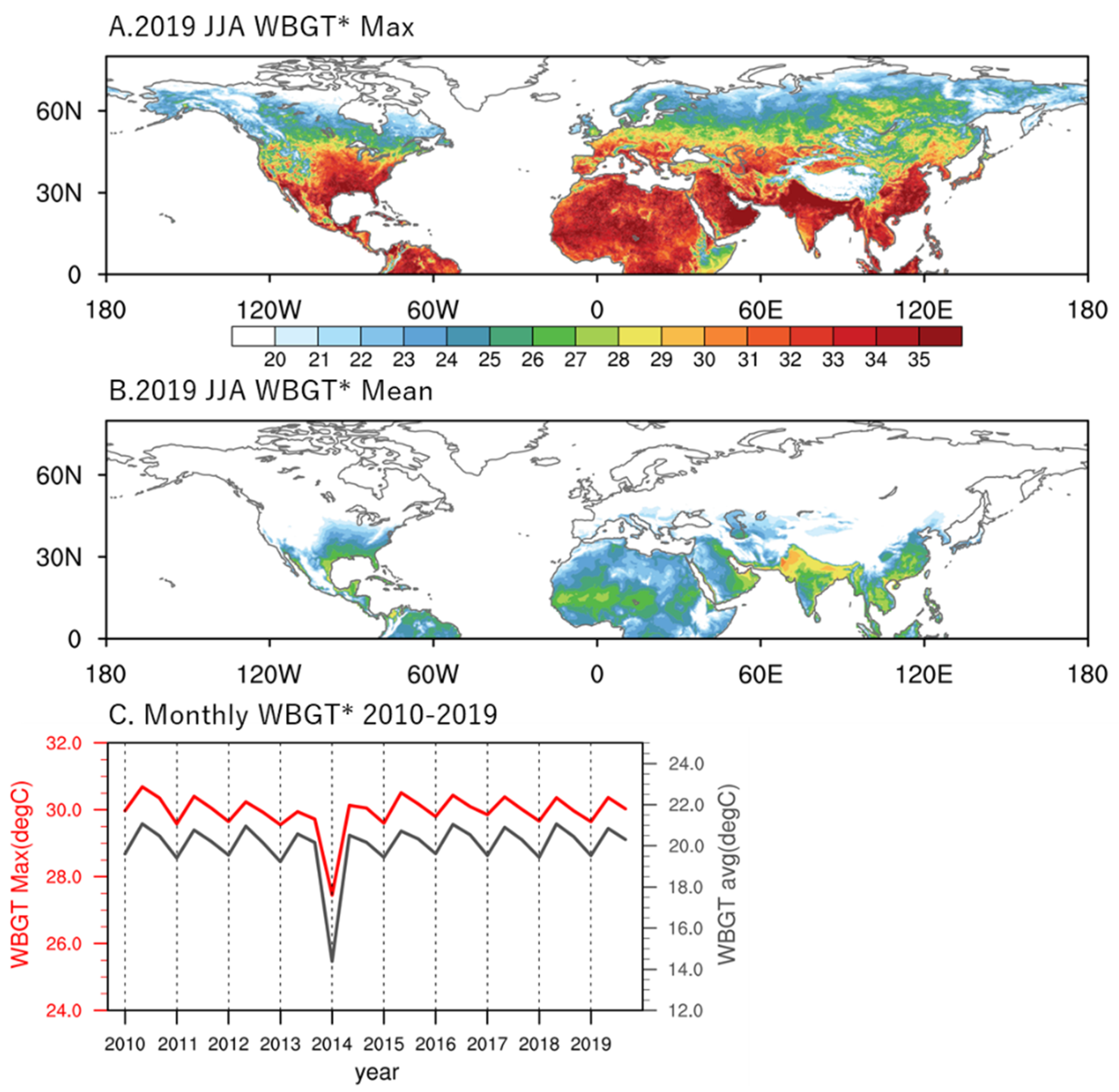
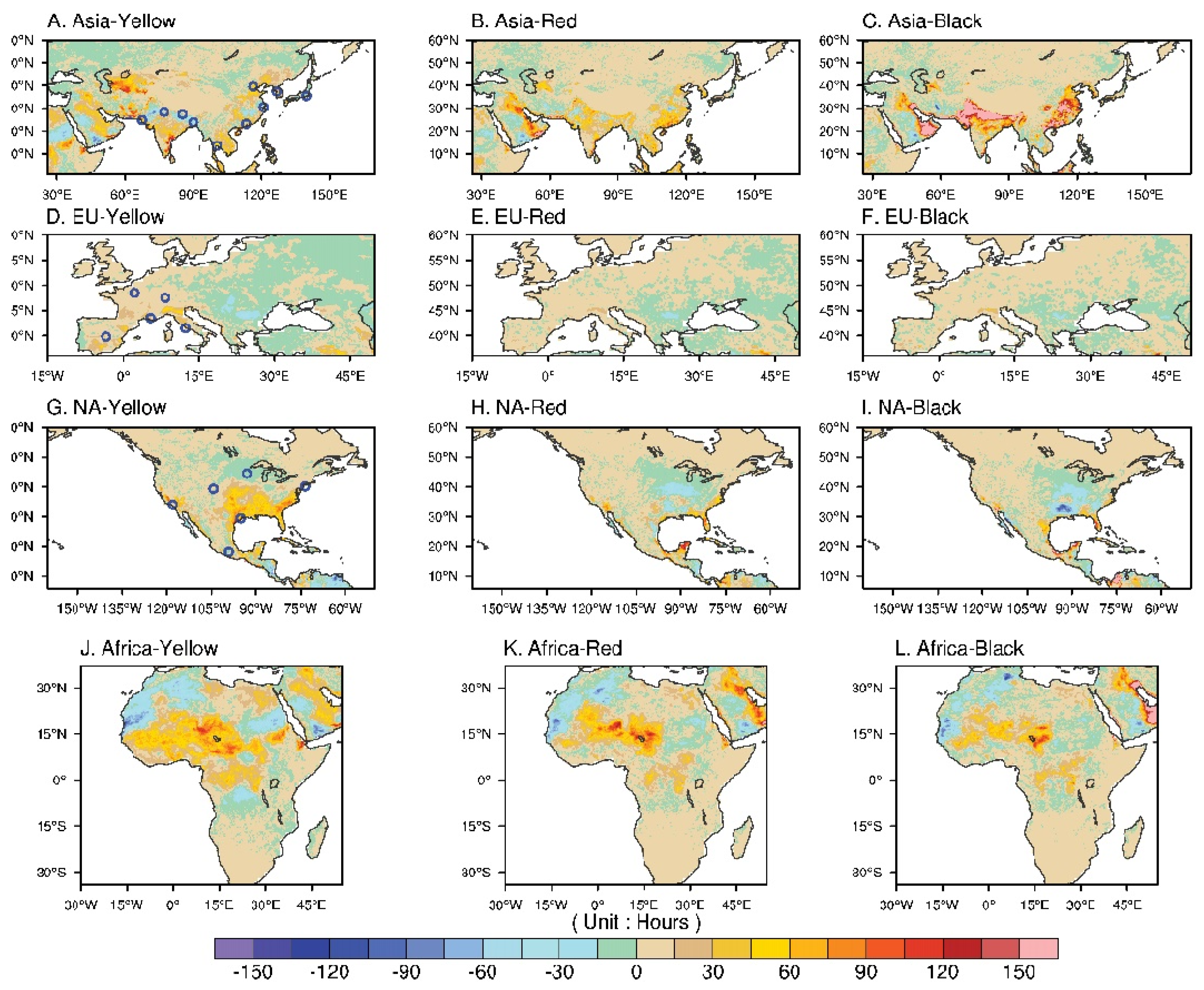
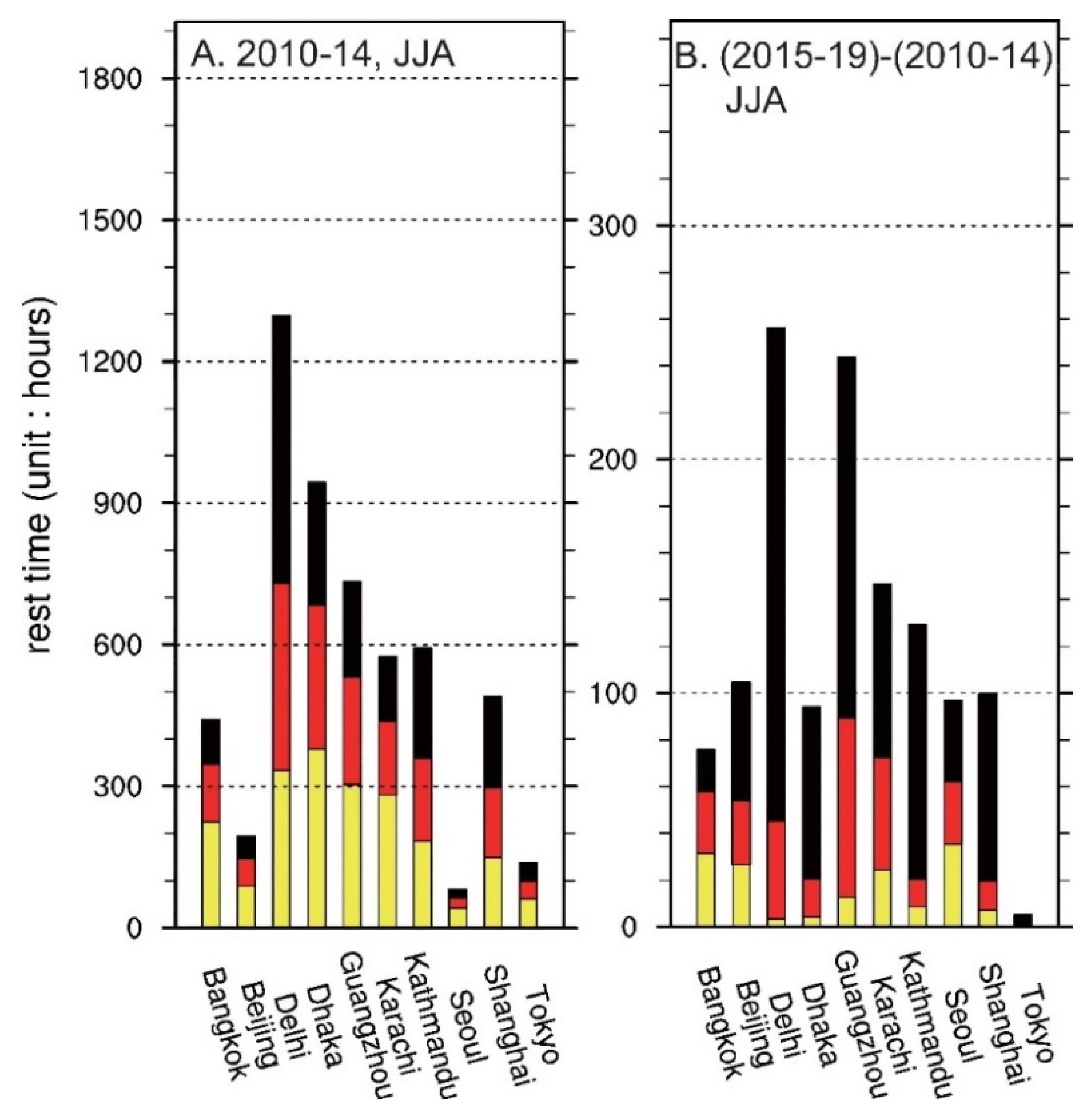
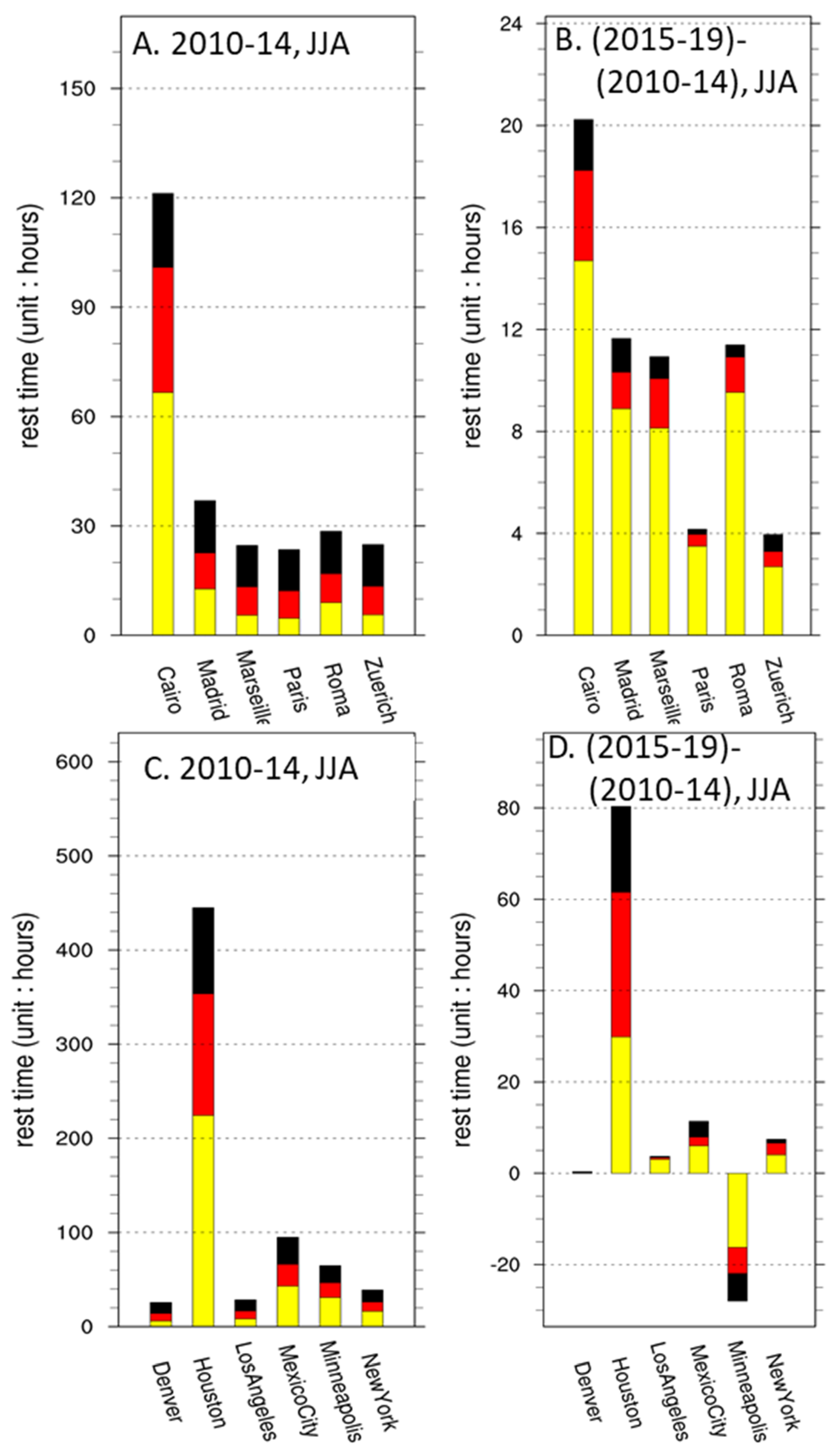

| Heat/Flag Category | WBGT Index (°C) | Resting Time (min h−1) |
|---|---|---|
| No flag | <29.4 | N/A |
| Yellow | 29.4–31.1 | 15 |
| Red | 31.1–32.2 | 30 |
| Black | >32.2 | 45 |
| Population (Thousand People) | ||
|---|---|---|
| Asia | Tokyo/Japan | 37,977 |
| Delhi/India | 29,617 | |
| Seoul/South Korea | 21,794 | |
| Bangkok/Thailand | 17,066 | |
| Dhaka/Bangladesh | 15,443 | |
| Karachi/Pakistan | 15,400 | |
| Kathmandu/Nepal | 3045 | |
| Shanghai/China | 22,120 | |
| Guangzhou/China | 20,902 | |
| Beijing/China | 19,433 | |
| Europe | Paris/France | 11,020 |
| Madrid/Spain | 6026 | |
| Roma/Italy | 3995 | |
| Marseille/France | 1605 | |
| Zurich/Switzerland | 805 | |
| Africa | Cairo/Egypt | 10,025 |
| North America | Mexico City/Mexico | 20,996 |
| New York/USA | 20,870 | |
| Los Angeles/USA | 15,402 | |
| Houston/USA | 6406 | |
| Minneapolis/USA | 2855 | |
| Denver, CO/USA | 2690 |
Publisher’s Note: MDPI stays neutral with regard to jurisdictional claims in published maps and institutional affiliations. |
© 2022 by the authors. Licensee MDPI, Basel, Switzerland. This article is an open access article distributed under the terms and conditions of the Creative Commons Attribution (CC BY) license (https://creativecommons.org/licenses/by/4.0/).
Share and Cite
Lee, S.-Y.; Lung, S.-C.C.; Chiu, P.-G.; Wang, W.-C.; Tsai, I.-C.; Lin, T.-H. Northern Hemisphere Urban Heat Stress and Associated Labor Hour Hazard from ERA5 Reanalysis. Int. J. Environ. Res. Public Health 2022, 19, 8163. https://doi.org/10.3390/ijerph19138163
Lee S-Y, Lung S-CC, Chiu P-G, Wang W-C, Tsai I-C, Lin T-H. Northern Hemisphere Urban Heat Stress and Associated Labor Hour Hazard from ERA5 Reanalysis. International Journal of Environmental Research and Public Health. 2022; 19(13):8163. https://doi.org/10.3390/ijerph19138163
Chicago/Turabian StyleLee, Shih-Yu, Shih-Chun Candice Lung, Ping-Gin Chiu, Wen-Cheng Wang, I-Chun Tsai, and Thung-Hong Lin. 2022. "Northern Hemisphere Urban Heat Stress and Associated Labor Hour Hazard from ERA5 Reanalysis" International Journal of Environmental Research and Public Health 19, no. 13: 8163. https://doi.org/10.3390/ijerph19138163
APA StyleLee, S.-Y., Lung, S.-C. C., Chiu, P.-G., Wang, W.-C., Tsai, I.-C., & Lin, T.-H. (2022). Northern Hemisphere Urban Heat Stress and Associated Labor Hour Hazard from ERA5 Reanalysis. International Journal of Environmental Research and Public Health, 19(13), 8163. https://doi.org/10.3390/ijerph19138163







